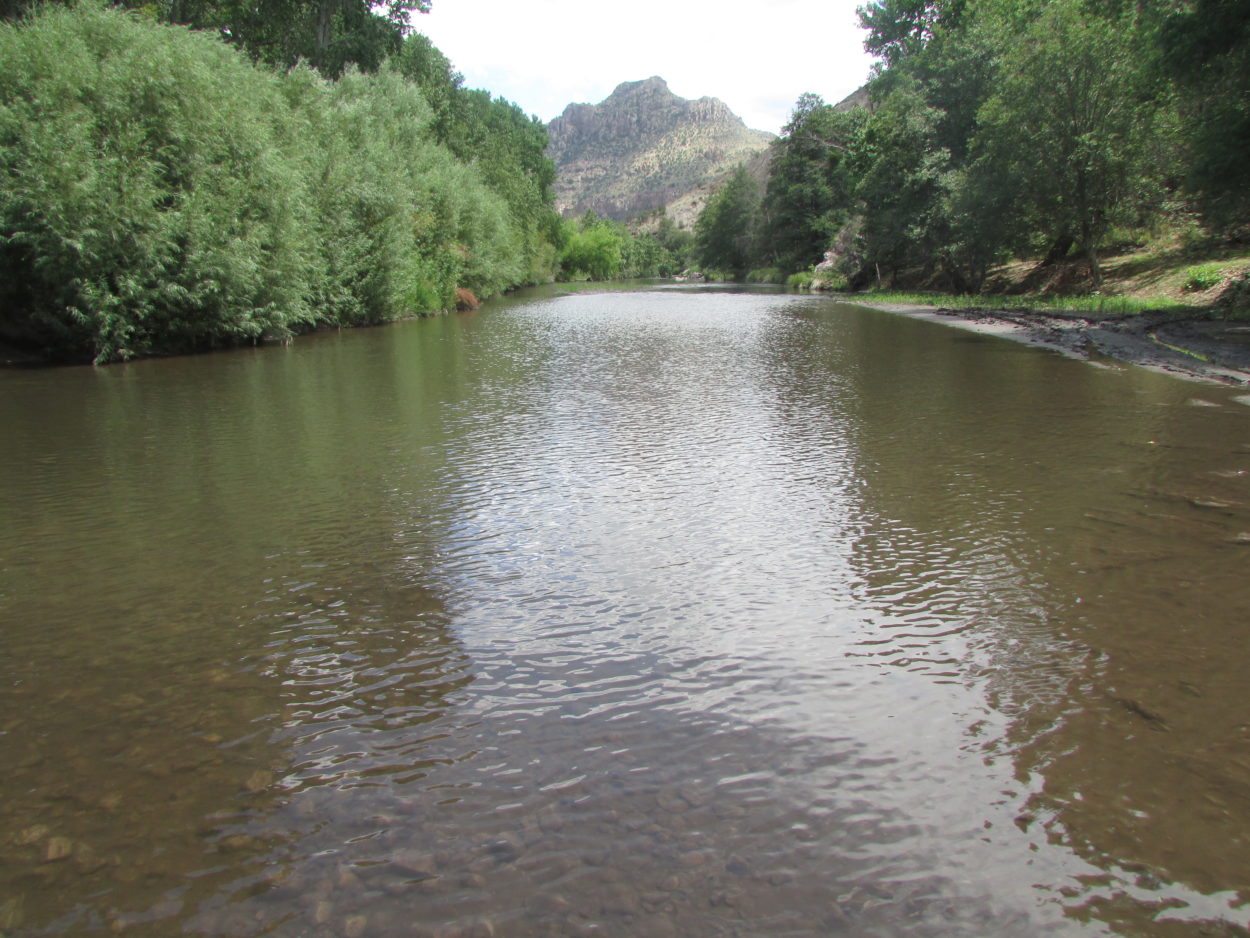New Mexico legislators tried to understand what’s happening with plans to divert water from the Gila River during a committee meeting earlier this week.
While the Senate Conservation Committee will hear related bills later this session, they first requested an update on the project’s plans and a recently issued engineering contract.
At its January meeting, the New Mexico Interstate Stream Commission (ISC) approved the New Mexico Central Arizona Project (CAP) Entity’s request to issue a quarter-million dollars in contracts for the diversion project. One of those contracts, for $150,000, is for Occam Consulting Engineers, Inc.
That company is owned by Scott Verhines, who was appointed State Engineer by Gov. Susana Martinez in 2011. As an ISC member, Verhines voted in 2014 to move forward with the diversion rather than use federal money for conservation and efficiency projects in the region. Among the company’s other “team members” is former ISC Director Estevan López. López was appointed by Gov. Bill Richardson in 2003 and reappointed in 2011 by Martinez.
Verhines and López both resigned their state positions in 2014.
At the committee meeting, Sen. Peter Wirth, D-Santa Fe, asked CAP Entity Executive Director Anthony Gutierrez to describe Occam’s contract.
Gutierrez said the entity wanted to hire a consulting engineer, “as they felt they might be disconnected between the contract engineer the ISC hired and the board itself.” Over the past few years, New Mexico has paid AECOM $1.37 million to design the diversion and its components—things like reservoirs or on-farm ponds—that the entity could propose to the federal government as a viable project.
Gutierrez added that Occum appealed to the board because it works with Engineers, Inc. which has an office in Silver City. He said the local firm would be able to “fill in any holes,” with the project. “We found it in good faith they would be able to have a local engineer, a local opinion, someone who knew about the area,” he said.
Changing plans
The ISC dates to the Territorial Legislature, which passed New Mexico’s Territorial Water Code, and the commission is mandated to “investigate, protect, conserve, and develop” New Mexico’s surface waters. The commission includes nine members, including the State Engineer, who serves as the commission’s secretary. All members are appointed by the governor.
That means water projects in New Mexico are subject to political winds. That has certainly been the case with the Gila diversion, which Richardson opposed and the Martinez administration supports.
The issue pivots around the 2004 Arizona Water Settlements Act. With that, Congress authorized New Mexico to exchange up to 14,000 acre feet of water with a downstream user in Arizona. It also gave the state 10 years to decide how it would use tens of millions of dollars in federal money. The state could pursue efficiency, conservation and restoration projects to meet water needs in Catron, Grant, Hidalgo and Luna counties—or receive additional funding and build a diversion on the Gila River.
With just one dissenting vote, in 2014 the ISC voted to build a diversion.
The following year, the state passed responsibility for planning and operating the diversion to a new, quasi-governmental organization, the New Mexico Central Arizona Project Entity.
But the entity has yet to submit a plan that triggers the start of environmental studies, which are a critical part of the process. For New Mexico to receive its full federal subsidy for the diversion project, the U.S. Bureau of Reclamation must issue a decision on the project by the end of 2019. This means the environmental work must be complete before then.
In 2016, the CAP Entity reduced its plans from an estimated $1 billion project to one that would supply water for between 50 and 100 farmers in the Gila-Cliff Valley. Since then, the plans have gone through a few more iterations. Gutierrez laid out the most recent plan for the senators: In October, he said, the CAP Entity submitted a plan to the U.S. Bureau of Reclamation that would cost about $44 million and potentially irrigate about 9,200 acres—though he acknowledged additional analysis would be required to “firm up those numbers.”
CAP Entity member Howard Hutchinson spoke from the audience, as well.
“We have done a lot of work on this,” he said. “Myself personally I have been engaged in this since 1973, and the amount of hours and travel that has been put into this by many different parties amounts to millions of dollars of investment in personal time and expenses.”
Hutchinson, who is with the San Francisco Soil and Water Conservation District, supports the diversion, and said the water would be used not just for agriculture, but also industrial and municipal uses. “The four southwest counties have high unemployment and high poverty levels and we are in desperate need for further economic development, to diversify away from agriculture and into manufacturing and industry,” he said. “The 14,000 acre feet isn’t just for 100 farmers in the Gila-Cliff Valley, this is for 58,000 people living in the southwest’s four counties.”
Least efficient farmers
Former ISC director and diversion opponent Norman Gaume also spoke to the committee, as well as Allyson Siwik, executive director of the Gila Conservation Coalition.
According to Gaume, Gila-Cliff Valley irrigators need efficiency improvements to their existing infrastructure, not additional water. His analysis of the state’s own data shows that the area’s farmers are among the least efficient in New Mexico. In 2014 and 2015, the area’s three ditches diverted 26,840 acre-feet of water each year to irrigate an average of 1,410 acres of land. That means the farmers are using 17.6 acre-feet of water for each acre annually.

“The New Mexico CAP Entity is still floundering,” said Siwik, who has been involved in the process since 2004. The entity, she said, plans to spend tens of millions of dollars on a project that will “yield only a tiny amount of water.” Under the current plans, the scaled-down project only has the capacity to divert and store about 1,800 acre feet of water annually.
Siwik noted that as currently planned, the project would benefit fewer than 50 irrigators, as well as Freeport-McMoRan Copper & Gold, Inc., which owns the area’s three copper mines. Decades ago, farmers sold their water rights to Phelps Dodge, which Freeport bought in 2007. Today, Freeport leases land and water back to the farmers in the valley. In total, fewer than 2,000 acres are currently irrigated in the valley—for pasture, not crops—and Freeport owns more than half those lands.
Siwik also explained that despite misconceptions about the 2004 legislation, New Mexico will not “lose” the 14,000 acre feet if it doesn’t build a diversion. “The right to exchange that water is in perpetuity,” she said. “That does not go away.”
Doubts and deadlines
Democratic Reps. Rodolpho “Rudy” Martinez, Bayard, and Bill McCamley, Doña Ana, are sponsoring a bill that would use the federal subsidy for projects other than the diversion, including a regional water project for Hurley, Bayard, Santa Clara and Silver City, and water planning in Deming.
“The CAP Entity that has been playing around with damming the Gila has had tens of millions of dollars at their disposal for years and has never really come up with a structured plan,” McCamley said, noting that the New Mexico Unit Fund has about $70 million left in it. “We should put that money to use on real water projects,” he said.
McCamley has watched the project for the five years he’s been in the Legislature—but hasn’t seen much progress.
“I tend to be pretty strong, environmentally, and I want to protect what we have in terms of natural beauty,” he said, referring to the environmental impacts of a diversion on the river. “But if we have a lot of money in a bank account that’s not being used, that’s a waste. We have a lot of needs that we have to take care of.”
Sen. Howie Morales, D-Silver City, is sponsoring the senate version of the bill. The Senate Conservation Committee scheduled Morales’s bill for Tuesday.
Last year, Morales and Republican Sen. Sander Rue, Albuquerque, co-sponsored a bill that would have required the ISC to answer certain questions about the diversion—such as where it will be built, how much it will cost, where additional funding will come from and how much water is available in the river—before it approved spending additional money. That bill died in the Senate Finance Committee.
This year, Legislative Finance Council analysts recommend funding only half the CAP Entity’s budget, which comes via the ISC, and requiring the CAP Entity to provide matching funding for their operating budget: “Given the failure of NMCAPE to select a project of significant public benefit and the reluctance of ISC to enter conversations about project prioritization, the Legislature should consider additional statutory constraints over ISC to ensure New Mexico unit funds are used to maximum benefit,” according to the budget proposal, which adds: “The requirement for NMCAPE to provide matching funding for their operating budget will assist in the long-term viability of the project; NMCAPE will be responsible for maintenance costs of the project once completed, requiring the ability to raise revenue.”
After presentations from Gutierrez, Siwik and Gaume, Committee Chair Sen. Joseph Cervantes, D-Las Cruces, again raised the specter of the 2019 federal deadline. Legislators have only this year’s 30-day session and next year’s session to give input into the project.
Already, New Mexico has spent more than $15 million on planning the diversion. The state has spent $13 million of the $90 million federal subsidy and spent another $2 million out of the state budget. In addition, Gutierrez noted, counties and cities have spent money on staffing and attorneys working on the project, as well.
“We’ve spent a lot of money, had a lot of meetings, and frankly I’ve got to wonder if it got us to a good result,” Cervantes said. “Watching this for 10, 14 years is for me like watching a train wreck in slow motion. I’m hoping we can still divert the wreck.”
To read all of our coverage of the Gila River diversion: https://nmpoliticalreport.com/tag/gila-river/






















